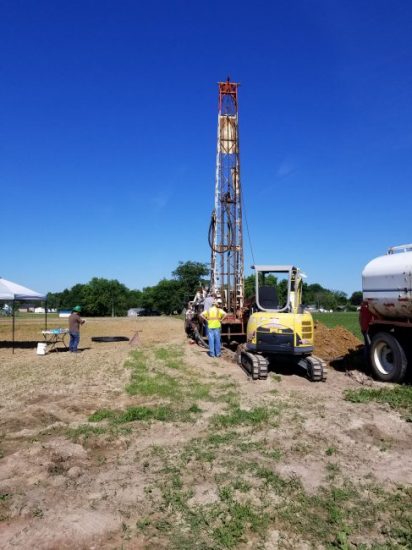Q: Where does our water come from/what is the treatment process?
We pump water from two wells located in Robein Subdivision from the Sankoty Aquifer. Water is pumped to our water treatment plant (WTP) where we treat the well water.
Water treatment process: NTPWD pumps an average of 650,000 gallons finished water daily.
- Aeration: brings water and air in close contact in order to remove dissolved gases (such as carbon dioxide) and oxidizes dissolved metals such as iron, hydrogen sulfide, and volatile organic chemicals (VOCs). Aeration is often the first major process at the treatment plant.
- Fluoridation: The addition of fluoride to the water supply (to prevent dental decay)
- Filtration: We use 12 pressure sand filters at the water treatment plant (WTP) for filtration. Similar to a pool filter, all twelve filters are “backwashed” three times weekly to increase sand quality and longevity of filter beds.
- Chlorination: A 12.5% liquid Sodium Hypochlorite is added at the plant and at two remote stations throughout the district. We maintain between a 0.50 and 2.0PPM (mg/L) residual in the distribution system. Chlorination is the process of adding chlorine to drinking water to disinfect, and kill germs. Different processes can be used to achieve safe levels of chlorine in drinking water. Chlorine is available as compressed elemental gas, sodium hypochlorite solution (NaOCl) or solid calcium hypochlorite (Ca(OCl)2
- Corrosion control (polyphosphates PO4): water treatment chemicals (dry or liquid solutions) used to correct problems resulting from inorganic groundwater contaminants (iron, manganese, calcium, etc.) and also to maintain water quality (inhibit corrosion, scale, biofilm, reduce lead and copper levels) in the distribution system.
- Pumping: the treated or “finished water” is pumped from a 200,000 gallon finished tank from the WTP to the water towers in the District.
- Distribution and Storage: We have two 500,000 gallon towers and one 100,000 gallon water towers in the district. Water towers are inspected every two years. Exterior inspection for structural reasons, more importantly interior inspections for water quality.
NTPWD maintains 1.1 million gallons in its towers for fire protection and residential use.
Q: Why switch to monthly billing from two month billing?
A: Due to the large amount of both leaks unknown from home owners and also confusion as to which month bills were due we decided to change to monthly billing. This will drastically reduce the amount of time that a leak can continue to be undetected and also lower confusion as to when bills are due.
Q: Why do we charge a Capital Improvement charge?
A: Capital Improvement charges go to any expansion or additions within the entire water district. These may include but are not limited to new water main extensions, new meters installed into every home in our district, new well development, and future water plant construction.
Q: Why do we flush hydrants every spring and fall?
A: Water Quality and hydrant exercise. With over 300 fire hydrants, we are able to move water at a high velocity thus removing any iron/manganese buildup that may accumulate or settle in mains during low usage times.
Q: Why may water be discolored in my home?
A: Elevated iron and manganese levels will cause a visible rust color to any potable water system. Although not a health risk, this is a major nuisance for any water system. The main reason we flush hydrants is to get the small amount of iron that may pass through our filters that has settled in the water mains. Any time there is a disruption in the mains, such as a water main repair, this may “stir up” the iron and be seen in the home.
Another big cause for discoloration is old residential plumbing. Our mains are flushed twice yearly, however, most residential plumbing is not cleaned or flushed for 30+ years. Working the same as our distribution system, indoor water pipes will build up with iron and release from time to time.
Q: Why is there a minimum charge for 0-3,300 gallons?
A: Most all water systems have a minimum charge for water and sewer. This is based on revenue and expense history and future expenditures. This is the calculated amount needed for day to day operations, maintenance of water treatment plant, repair of distribution system, and tower maintenance.